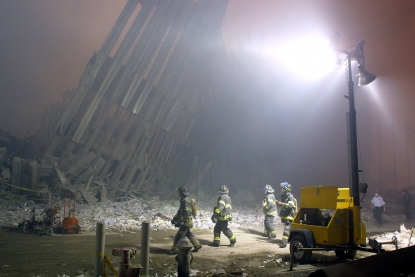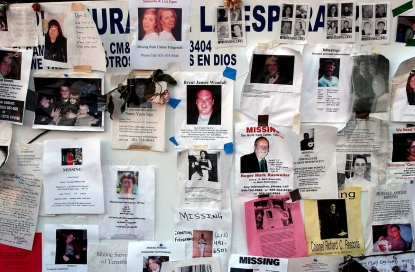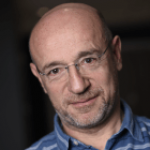The morning "a fire broke out"
PARIS - September 11, 2001, 20 to nine on a beautiful sunny morning in New York. The view from the windows of the AFP bureau, on the 34th floor of a Manhattan tower block, is glorious. The chrome eagle heads on the corners of the Chrysler building, spruced up a week ago by cleaners who looked like sky acrobats, are shining brilliantly in the clear blue sky. For more than a year I'd been sending faxes asking permission to go and see them work, to do a story on them -- without success.
I put my motorbike helmet down and say hello to my colleague Christophe Vogt, who is wading through company results and economic papers. Switch on the TV and there is the blue and white logo of New York One, the rolling news channel covering the Big Apple's five boroughs. I take the lid off my Starbucks cappuccino -- double shot, extra hot -- and give it a stir with my green biro, as usual.
 (AFP / Stan Honda)
(AFP / Stan Honda)The NY1 anchor says they're getting reports of a fire high up in one of the World Trade Center towers, as the picture switches to automatic cameras mounted on skyscrapers, which constantly film the southern part of Manhattan.
I've been one of AFP's journalists in New York for two years. Long enough to have learned that when something happens to one of the defining landmarks on the city's famous skyline-- the Empire State Building, the Brooklyn Bridge, the Statue of Liberty or the twin towers of the WTC -- it's a story.
Based on the TV images -- we don't have a view of the towers, which are on the far south of Manhattan island -- I start bashing out a simple, straightforward story, a "factuel" in AFP-speak, headlined "Fire breaks out in World Trade Center tower". The gaping hole smashed in the side of the building is masked by the smoke, and from the TV pictures it really does look like a fire.
Then the NY1 anchor mentions witnesses talking about a plane hitting the tower. I think "A plane? How could a pilot crash into the Twin Towers when there's all that space around them? Was he taken ill?" Then the phone rings. It's AFP Washington, North America editor-in-chief Francis Kohn calling direct.
-- Michel, are you watching CNN?
-- No, New York One.
-- Put CNN on.
The NY1 camera was filming from the north looking south and was not on when American Airlines Flight 11 plunged into the north tower.
 (AFP / Doug Kanter)
(AFP / Doug Kanter)The first breaking news bulletin hits the AFP wire at 8:55 am New York Time: "Plane crashes into New York World Trade Center".
A commercial airliner? My mind turns to "Operation Bojinka", a 1995 plot by radical Islamists Ramzi Yousef and Khalid Sheikh Mohammed to blow up US airliners over the Pacific that was foiled by the Philippines. A few months earlier I had covered the first hearings in a New York court over the 1998 bombings of US embassies in Kenya and Tanzania, during which the idea of using airliners as missiles had been mentioned.
(Former AFP photographer Stan Honda took some of the most well-known images of the September 11 attacks. In the video above, he looks back on the events of that momentous day).
Then at 9:03 am, live on TV, United Airlines Flight 175 smashes into the south tower. Good god, what is happening? It's going to be a long day -- and a long night.
The bosses in Washington decide to send our two UN correspondents, Michel Leclercq and Robert Holloway, to the scene. They manage to jump on the last subway before the service is shut down. Eyes glued to the TV, the chief editors on the phone, I fire off the stories. First update: "Two planes smash into New York's World Trade Center twin towers".
 Pedestrians walk across the Brooklyn Bridge away from the burning World Trade Center (AFP / Henny Ray Abrams)
Pedestrians walk across the Brooklyn Bridge away from the burning World Trade Center (AFP / Henny Ray Abrams)A minute before 10:00 am, after burning for 56 minutes, the south tower wobbles slightly and collapses, as if in slow motion, leaving behind a ghostly trace of itself in dust. Appalling. It takes me 30 seconds to comprehend what I am seeing and send the breaking news bulletin. Twenty-eight minutes later the north tower collapses. I should have been expecting it, been ready for it, but like everyone else I am transfixed, incredulous, frozen in horror.
URGENT: "The second tower of the World Trade Center, hit by a commercial jet aircraft, exploded and collapsed on itself just minutes after the other tower disintegrated into a heap of rubble and dust."
 The first tower collapses (AFP / Doug Kanter)
The first tower collapses (AFP / Doug Kanter)In the bureau Valerie Leroux, our second economics journalist, arrives just ahead of Matthieu Rabechault, a journalism student doing an internship with us. With Christophe, we gather details, eyewitness accounts, information that we send to Washington where the main "wraps" are being written. Washington, where at 9:37 am another airliner smashes into the Pentagon building.
How many more hijacked planes are still in the air? What are the targets? The White House? The Capitol? The UN headquarters three streets away from us? How many dead will there be? I remember that Operation Bojinka planned to target 11 planes.
The people behind this attack have pulled it off, probably better than they ever dreamed was possible. On Manhattan, the subways have stopped, traffic is at a virtual standstill. Following advice from mayor Rudy Giuliani, people in the southern tip of Manhattan, below Canal Street, are starting to move north. A silent, dazed crowd, some of them covered with a layer of grey dust, is on the move.
 Marcy Borders, who could escape from one of the twin towers after the attack. Ms Borders died from cancer in August, 2015 (AFP / Stan Honda)
Marcy Borders, who could escape from one of the twin towers after the attack. Ms Borders died from cancer in August, 2015 (AFP / Stan Honda)The mobile phone network is flooded, so there's no way to contact Robert, Michel or our photographer Stan Honda. Their partners ring us regularly and I don't know what to say to them -- I am not able to tell them no, don't worry, they weren't in the towers when they collapsed. After several hours they arrive on foot at the AFP bureau on 46th Street, where we welcome them as heros. They start to write their reports from the scene.
With them back in the bureau, I go to take over at the scene. Since arriving in the US, I've had to retake my test and pay through the nose for a parking spot, but never have I been more grateful to be one of Manhattan's rare motorbike riders. Only a few police and fire department vehicles are going down Third Avenue, sirens blaring. A few taxis are hurrying north towards Harlem. The pavements are packed with people. At Canal Street a policeman points his gun to stop me. Nobody south of Canal! But in a country that pays no heed to the press card, the one issued by the NYPD still opens doors.
-- If I park here in the gas station and keep going on foot, is that OK?
-- OK, be careful.
In a cathedral-like silence, which I have only known in New York on snowstorm days, I walk towards the black cloud, the reflections of the fire that can be seen above the roofs. It's not snow that is accumulating on the road, but a strange substance, a mix of ash, dust and sheets of paper. On the corner of Greenwich and Harrison, the covering gets thicker, smothering everything. The street, cars, signs, mailboxes, fire hydrants, bins, newspaper racks, traffic lights, scaffolding, a dog helplessly trying to shake itself clean, all disappear under a 15-centimetre (six-inch) blanket of powder. The grey shroud muffles sounds and footsteps so that only the sirens of the police and fire department echo from afar. There are shoes everywhere, most of them women's -- high heels abandoned to run quicker.
In the middle of Barclay Street, the white-faced figure of a policeman moves forward with tiny steps. He looks straight ahead but seems to see nothing, his shoulders slumped, his feet dragging, mouth open. His gun holster is empty, his truncheon hangs upside down at his back. I ask him if he's okay, if he wants some water, if I can keep going towards the WTC. He turns his head, his gaze goes through me and he does not answer. He sits down on something, takes off his cap and hits it against his leg then breaks into silent sobbing.
 An exhausted police officer tries to rest near the World Trade Center (AFP / Stan Honda)
An exhausted police officer tries to rest near the World Trade Center (AFP / Stan Honda)The husky roar of jet planes tears through the evening air. Two bright spots burst above my head, military jets. A police officer murmurs "God I hope they're ours." He checks my NYPD card and lets me pass.
I turn right onto West Broadway and there, at the end of the avenue, the two 110-storey towers which I'd seen from every corner of New York, which I'd used to navigate when I got lost in the Bronx or New Jersey, which stood like lookouts on foggy nights -- all that is left is this, a smoking, chaotic wreck whose outline I could barely make out.
 (AFP / Doug Kanter)
(AFP / Doug Kanter)Flames are escaping from the tangle of metal, twisted beams, collapsed walls, heaps of rubble. How tall is it? I count the floors of an adjacent building, which has survived intact. Four, five, six -- 110 storeys compacted into just six. There are fires everywhere, bursting out and disappearing. Firefighters' giant jets of water are falling like rain. On the right a red truck has been flattened into a metal pancake just 24 centimetres thick.
"Hey you, you're not going any further. NYPD card? I don't care. Get out of here, can't you see it's dangerous? Look, we're putting up barriers. Get out of here or I'll arrest you!"
 South Manhattan at dawn, on September 12 (AFP / Tannen Maury)
South Manhattan at dawn, on September 12 (AFP / Tannen Maury)Police reinforcements arrive and gradually push back the reporters, cameramen and photographers. We are all torn between horror at witnessing such scenes and excitement at being there, at Ground Zero. Some might find this distasteful but is part of the journalist's job -- we know history is being made, and for a reporter this is the place to be.
Taking in as many images and sensations as possible. A few phrases, a smell, a gesture, a scene, a word -- the story taking form in my head practically writes itself. I try to keep it simple -- the story is so strong, so enormous, so beyond anything else that nothing needs to be added. Less is more.
 Manhattan, September 19 (AFP / Eric Feferberg)
Manhattan, September 19 (AFP / Eric Feferberg)I go around the site, meet haggard firefighters, police officers in shock, Red Cross workers looking a bit lost with do few casualties to treat. I look at my watch and see it's time to head back to the office, to write the story in time for European deadlines.
I find my Suzuki bike under the canopy of the gas station, guarded by a young police officer with a sad smile. I pass by City Hall, deserted, Union Square where the first candles are being lit, where strangers are hugging, by Brooklyn Bridge where the crowd of pedestrians is starting to thin out. Back in the bureau, all the TVs are on, there is a serious atmosphere, tense but calm, and friends and colleagues are happy to see me return.
 A firefighter at 'Ground Zero', three days after the attack (AFP / Tannen Maury)
A firefighter at 'Ground Zero', three days after the attack (AFP / Tannen Maury)(This article was translated from French by Damon Wake in Paris)






